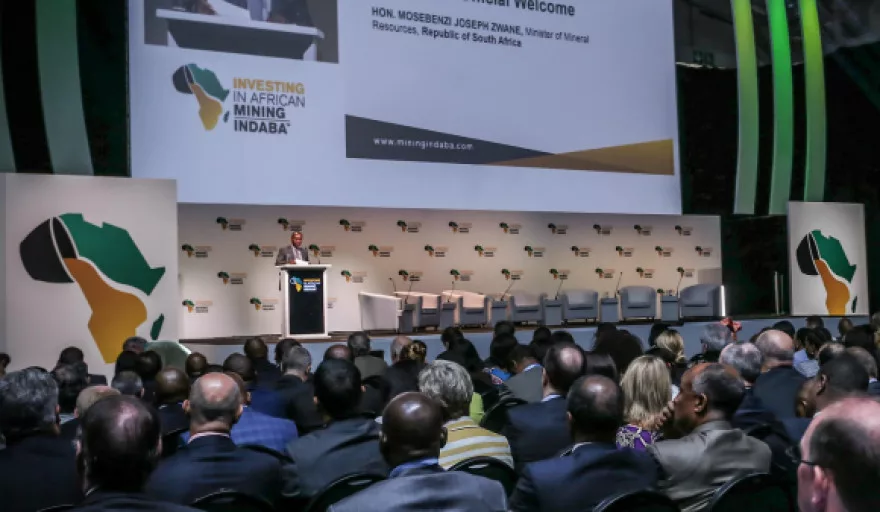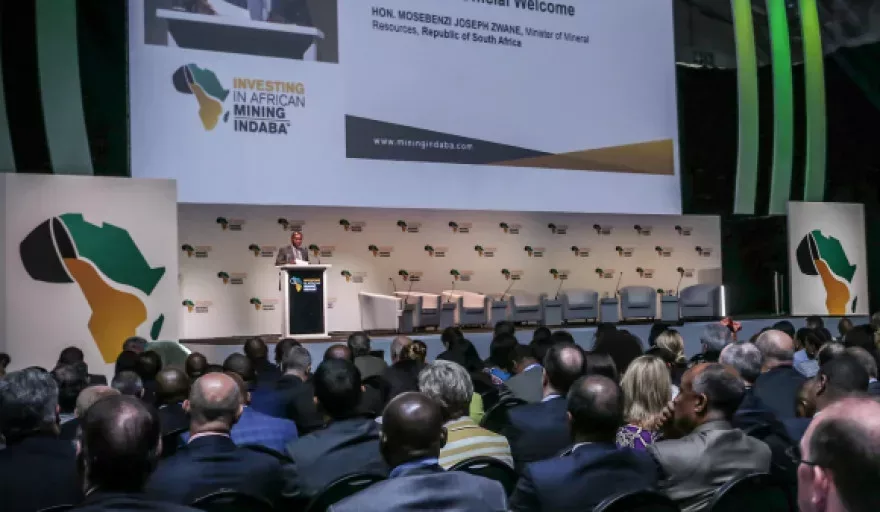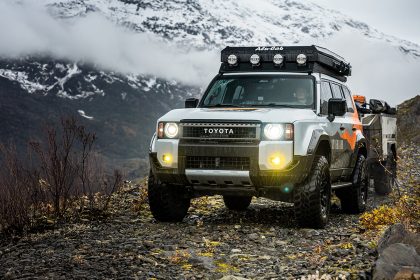
Africa’s leading mining extravaganza returned in 2016 with renewed optimism once again that the unprecedented levels of collaboration and knowledge sharing would go some way in alleviating the challenges currently being experienced across the industry in Africa.
Investing in African Mining Indaba 2016 attracted nearly 6,000 delegates, incorporating all critical players across the African mining investment chain, comprising attendees from 94 countries and representing the full array of sector strands; investors, mining enterprises, government ministers, government officials and service providers in mining-adjacent industries.
Despite the slight – and expected, due to the general market decline – slump in attendance against 2015’s figures, there was certainly no slump in the quality of attendees from the aforementioned sectors, with the investment domain out in force, in particular. Overseeing it all though was the Managing Director of Investing in African Mining Indaba, Jonathan Moore, and he mused over the recent proceedings, the state of the industry in general, and how he sees the situation developing between now and next year’s gathering.
Africa Outlook (AfO): What was unique about this year’s Mining Indaba compared to previous years, and what were the reasons for this?
Jontathan Moore (JM): Mining Indaba is first and foremost about investing in mining, and all enhancements to the 2016 programme addressed some form of investment; be it financial, human capital, or sustainability.
The most notable changes that we made this year included the start time of the conference with the event beginning half a day earlier to allow more time for new networking activities and additional sessions, as well as the creation of the Director of Investor Relations role as part of an enhanced investor programme.
In advance of this year’s event, Kael O’Sullivan was brought on to identify and engage with those investors that we believed should be participating in Mining Indaba. He was charged with recruiting the investment community and ensuring that they received the maximum value from their participation. He also helped to identify key topics that investors wanted to discuss.
Kael put investors in touch with the mining companies that they wanted to meet with as well as strategically structure the time they spent at the conference. This further strengthened the primary focus of Mining Indaba; connecting investors with mining companies so they might effectively explore investment opportunities and deploy capital in African mining projects. With this key role in place we effectively doubled the number of investors participating in the programme this year.
AfO: The emphasis on networking has inevitably been a recurring theme over the years of Mining Indaba, so how was this further facilitated in 2016 in line with this drive to encourage increased investment discussion in the future?
JM: Our attendees make clear that one of the key reasons they attend Mining Indaba is to network. We wanted to further ensure that the event was creating opportunities for likeminded people to meet, and the new networking activities were highly successful toward this end; including speed networking, networking roundtables and business matchmaking.
There was also the introduction of the Young Leaders Career Development Programme. This year’s theme, Investing Beyond the Mining Cycles, focused on what the industry can do today to positively impact the future. Helping to ensure there are well-trained and inspired leaders in the future is key.
Identifying the right candidates for the jobs that are available is becoming increasingly difficult as graduates are looking at alternative industries under the current market conditions. This free programme, attended by more than 100, was introduced to help students and graduates identify the skill sets that the industry requires now and into the future, as a way to prepare the leaders of tomorrow for success.
AfO: What specific industry trends and themes dictated the key talking points in this year’s event and in what ways did the event address these?
JM: Investing in African Mining Indaba remains the world’s largest mining investment conference and Africa’s largest mining event. However we are ever cognisant that this event exists to serve the ever-changing needs of Africa’s mining industry. Considering the challenges that the market has been facing – and confirmed by the input we received from our vast network of investors, mining executives and government representatives – we set the 2016 theme as Investing Beyond the Mining Cycles.
We commonly hear people say ‘mining is a cyclical industry, you just have to work through the cycles’. With 2016 Investing in African Mining Indaba, we used the platform to bring together key stakeholders to explore what the sector is doing to strengthen its position in the current environment but also to discuss investment strategies that better position the industry for a time when the inevitable demand for commodities begins to grow.
The current market has resulted in organisations taking a hard look at how they do business and what they can do to improve efficiencies of operations, to evaluate how best to make investments into the mining sector while mitigating associated risks, and to identify the partnerships that will be critical to the future development and acceptance of mining in the years to come. We strived to create the platform that would encourage these discussions.
There will also be a greater emphasis on sustainability with companies having to incorporate it into their business from the outset. Investors are paying increasingly more attention to how mining companies are operating and want to engage with companies that are taking sustainability seriously.
As a platform that brings the mining companies together, we have a responsibility to ensure that the key issues around investment are being addressed. This critical topic ran throughout the 2016 programme.
AfO: Could you also talk me through some of the speakers at Mining Indaba 2016 and what you feel they brought to the table in terms of industry knowledge and international expertise?
JM: The 2016 agenda had more than 250 speakers and more sessions than ever before, covering a wide array of topics from investment strategies, to alternative forms of financing, to infrastructure, to innovation and sustainability. We brought in the most knowledgeable and experienced industry leaders to impart their knowledge and spark debate.
South Africa’s Minister of Mineral Resources, H.E. Mosebenzi Joseph Zwane gave his very first public address. We had finance experts on the agenda like H.H. Lamido Sanusi, Emir of Kano and Chairman, Black Rhino Group; Oliver Andrews, Executive Director and Chief Investment Officer of Africa Finance Corporation; and Nonkululeko Nyembezi-Heita, Chairman, Johannesburg Stock Exchange.
We had top mining company CEOs speak including Mark Cutifani of Anglo American; Alan Davies, Chief Executive of Diamonds and Minerals at Rio Tinto; and Graham Kerr with South32.
There was also a strong representation of mining ministers from 18 African nations including Federal Democratic Republic of Ethiopia, Republic of Guinea, Kingdom of Lesotho, Republic of Zimbabwe, Republic of Cameroon, Republic of Sierra Leone, Kingdom of Morocco, Republic of Mali, Republic of Liberia, Democratic Republic of Congo, Republic of Botswana, Republic of Côte d’Ivoire, Burkina Faso, Republic of Madagascar, Republic of Kenya, Republic of Namibia, Republic of the Sudan, and Republic of Zambia.
AfO: From a more general industry perspective, what do you feel are the biggest challenges and trends influencing the mining industry in Africa at present, and how do you see these issues unfolding over the coming months and years?
JM: No doubt the issues surrounding commodity prices and other market conditions will continue to play themselves out. We may see industry compression coming in many forms from downsizing to M&A and beyond.
One thing that was quite encouraging at this year’s Mining Indaba was the sentiment of investors. We heard them talk about great buying opportunities. Some that I spoke with have already begun to re-engage parts of their portfolio and put capital back into the sector because of these strong buying opportunities in the market.
As is a typical part of the cyclical nature of this industry, when we hit these low points we see mining companies scale back on exploration. As the number of new projects come on-line less frequently this becomes a critical element of the supply and demand mechanism of the sector that begins to move it toward an upswing.
How that was expressed here at Mining Indaba was most evident in the investor programme. We look at what the investors here are doing and how they’re going about their business; the types of meetings they’re having and who they’re having them with. It’s markedly different than last year. Last year we saw very little interest in projects that were not in production or about to move into production. This year there is a lot more discussion about exploration and new projects that show potential.
I also expect that discussions around infrastructure and sustainable development will only increase in time as well.
AfO: Finally and similarly, what are your aspirations and expectations for Mining Indaba as an event moving forward and how would you like to see it grow from 2016 onwards?
JM: The mission of Mining Indaba has always been and will continue to be the presentation of a unique platform for the capitalisation and development of mining interests in Africa. We remain committed to making this the best event for connecting mining companies with government and the investment community.
In the end, there is no other event that exclusively brings these three market segments together and places its emphasis on creating opportunities for financing mining projects on the African continent. We will continue to invest our own resources to ensure that this remains the overriding focus of the event, even as we expand our coverage of other important areas such as sustainable development and career development.
Mining Indaba will continue to be an “ecosystem” with many components ranging from networking, deal-making, discussion, education, off-site events, a charity golf outing, career development and more. All of this makes these four days in Cape Town the centre of the mining world.
We consistently see, even in a down market that the quality of the attendees remains extremely high, affirming the ongoing importance of Mining Indaba to investment in African mining.































